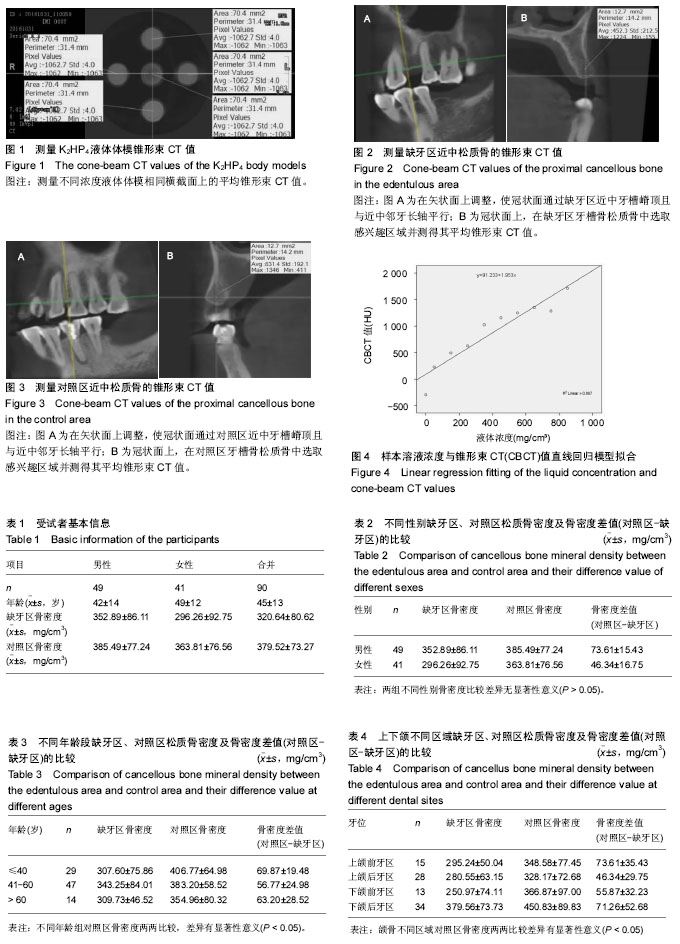| [1] Zhang DZ, Xiao WL, Zhou R, et al. Evaluation of bone height and bone mineral density using cone beam computed tomography after secondary bone graft in alveolar cleft. J Craniofac Surg. 2015;26(5):1463-1466.[2] Jeroen VD, Laura FPN, Yan H, et al. Accuracy and reliability of different cone beam computed tomography (CBCT) devices for structural analysis of alveolar bone in comparison with multislice CT and micro-CT. Eur J Oral Implantol. 2017; 10(1):95-105.[3] 马雨聪,郭德惠,谭包生.即刻种植的临床研究[J].口胞颌面修复学杂志,2013,14(1):47-50.[4] Andruch K, P?achta A. Evaluating maxilla bone quality through clinical investigation of voxel grey scale values from cone- -beam computed tomography for dental use. Adv Clin Exp Med. 2015;24(6):1071-1077. [5] 杨小明,刘静,熊海,等.定量CT测量骨密度的准确性研究[J].中国临床康复,2004,8(18):3594-3595.[6] Naitoh M, Hirukawa A, Katsumata A, et al. Evaluation of voxel values in mandibular cancellous bone: relationship between cone-beam computed tomography and multislice helical computed tomography. Clin Oral Implants Res. 2009;20(5): 503-506.[7] Hao Y, Zhao W, Wang Y, et al. Assessments of jaw bone density at implant sitesusing 3D cone-beam computed tomography. Eur Rev Med Pharmacol Sci. 2014;18: 1398-1403.[8] Hohlweg-Majert B, Metzgerb MC, Kummerc T. Morphometric analysis-Cone beam computed tomography to predict bone quality and quantity. J Craniomaxillofac Surg. 2011;39: 330-334.[9] Marquezan M, Souza MMG, Araújo MTS, et al. Is miniscrew primary stability influenced by bone density? Braz Oral Res. 2011;25(5):427-432.[10] Cha JY, Kil JK, Yoon TM, et al. Miniscrew stability evaluated with computerized tomography scanning. Am J Orthod Dentofacial Orthop. 2010;137(1):73-79.[11] Varshowsaz M, Goorang S, Ehsani S, et al. Comparison of tissue density in hounsfield units in computed tomography and cone beam computed tomography. J Dent. 2016;13(2): 108-115.[12] Chindasombatjaroen J, Kakimoto N, Shimamoto H, et al. Correlation between pixel values in a cone-beam computed tomographic scanner and the computed tomographic values in a multidetector row computed tomographic scanner. J Comput Assist Tomogr. 2011;35(5):662-665.[13] Pauwels R, Jacobs R, Singer SR, et al. CBCT-based bone quality assessment: are Hounsfield units applicable? Dentomaxillofac Radiol. 2014;44(1):46-51.[14] Nackaerts O, Maes F, Yan H, et al. Analysis of intensity variability in multislice and cone beam computed tomography. Clin Oral Implants Res. 2011;22:873-879.[15] 刘珺,王维,董琼娟,等.双能X射线骨密度仪(DXA)与定量CT(QCT)测量骨密度的比较研究[J].临床放射学杂志,2007, 26(5):504-507.[16] 潘诗农,赵衡,赵凯,等.基于QCT数据无体模CAD股骨颈BMD测量初步研究 [J].中国临床医学影像杂志,2009,20(3):178-183.[17] 康宁,宫苹.颌骨骨密度的研究进展 [J].国际口腔医学杂志, 2009,36(3):370-373.[18] 刘瑞,汪方,张洁,等.定量CT测定骨矿物质密度研究进展 [J].国际骨科学杂志,2012,33(4):234-239.[19] Mueller DK, Kutscherenko A, Bartel H, et al. Phantom-less QCT BMD system as screening tool for osteoporosis without additional radiation. Eur J Ratiol. 2011;79(3):375-381.[20] Lekovic V, kenney EB, Weinlaendar M, et al. A bone regenerative approach to alveolar ridge maintenance following tooth extraction. Report of 10 cases. J Periodontol. 1997;68(6):563-570.[21] Wheel SL, Vogel RE, Casellini R. Tissue preservation and maintenance of optimium aesthetics: a clinical report. Int J Oral MaxillofaImplant. 2000;15(2):265-271.[22] 杨明德.拔牙后牙槽嵴位点保存在口腔种植学中的应用[J].国际口腔医学杂志,2012,39(2):211-213.[23] 王承勇.拔牙窝愈合过程中新骨形成及骨量保持的可能调节作用机制研究[D].福建:福建医科大学,2010.[24] 李琼,王佐林.口腔即刻种植的研究进展[J].口腔颌面外科杂志, 2011,21(1):55-58.[25] van Daatselaar AN, Dunn SM, Spoelder HJ, et al. Feasibility of local CT of dental tissues. Dentomaxillofac Radiol. 2003; 32:173-180. [26] Bhola M, Neely AL, kdhatkar S. Immediate implant placement : clinical decisions, advantages, and disadvantages. J Prosthodant. 2008;17(7):576-581.[27] 于世风.颌骨骨代谢调控研究的现状及展望[J].中华口腔医学杂志,2007,42(3):129-131.[28] 张真.锥形束CT测量分析预种植区颌骨质量[D].乌鲁木齐:新疆医科大学,2010.[29] Azeredo F, DE Menezes LM, Enciso R, et al. Computed gray levels in multisliceand cone-beam computed tomography. Am J Orthod Dentofacial Orthop. 2013;14(4):147-155.[30] 钱文涛,张瑛,蒲益萍,等.下颌后牙区骨组织与种植体初期稳定性的相关性研究[J].中国口腔种植学杂志,2013,18(10):1-6.[31] Norton RM, Gamble C. Bone classification: an objective scale of bone density usig the computerized tomography scan. Clin Oral Implants Res. 2001;12(2):79-84.[32] Fanuscu MI, Chang TI. Three dimensional morphometric analysis of human cadaver bone: microstructural data from maxilla and mandible. Clin Oral Implants Res. 2004;15(2): 213-218.[33] Turkyilmaz I, Tumer C. Bone density assessments of oral implant sites using computerized tomography. Oral Rehabil. 2007;34:267-272. |
.jpg) 文题释义:
定量CT:即定量X射线计算机体层摄影技术,区别于传统CT的特点是体模的运用,校正CT值漂移,从而准确地测量出单位体积内的骨矿物质含量,弥补了CT值只能代表相对骨密度的缺点。
定量CT测量体积密度:定量CT可分别测量任何部位骨小梁和皮质骨单位体积内的骨矿含量,即体积密度,单位以“mg/cm3”表示。测量时,除计算机软件设定感兴趣区外,还需外加一个标准体模,以校准机器的漂移,并将CT值换算成骨密度值。
文题释义:
定量CT:即定量X射线计算机体层摄影技术,区别于传统CT的特点是体模的运用,校正CT值漂移,从而准确地测量出单位体积内的骨矿物质含量,弥补了CT值只能代表相对骨密度的缺点。
定量CT测量体积密度:定量CT可分别测量任何部位骨小梁和皮质骨单位体积内的骨矿含量,即体积密度,单位以“mg/cm3”表示。测量时,除计算机软件设定感兴趣区外,还需外加一个标准体模,以校准机器的漂移,并将CT值换算成骨密度值。.jpg) 文题释义:
定量CT:即定量X射线计算机体层摄影技术,区别于传统CT的特点是体模的运用,校正CT值漂移,从而准确地测量出单位体积内的骨矿物质含量,弥补了CT值只能代表相对骨密度的缺点。
定量CT测量体积密度:定量CT可分别测量任何部位骨小梁和皮质骨单位体积内的骨矿含量,即体积密度,单位以“mg/cm3”表示。测量时,除计算机软件设定感兴趣区外,还需外加一个标准体模,以校准机器的漂移,并将CT值换算成骨密度值。
文题释义:
定量CT:即定量X射线计算机体层摄影技术,区别于传统CT的特点是体模的运用,校正CT值漂移,从而准确地测量出单位体积内的骨矿物质含量,弥补了CT值只能代表相对骨密度的缺点。
定量CT测量体积密度:定量CT可分别测量任何部位骨小梁和皮质骨单位体积内的骨矿含量,即体积密度,单位以“mg/cm3”表示。测量时,除计算机软件设定感兴趣区外,还需外加一个标准体模,以校准机器的漂移,并将CT值换算成骨密度值。
.jpg) 文题释义:
定量CT:即定量X射线计算机体层摄影技术,区别于传统CT的特点是体模的运用,校正CT值漂移,从而准确地测量出单位体积内的骨矿物质含量,弥补了CT值只能代表相对骨密度的缺点。
定量CT测量体积密度:定量CT可分别测量任何部位骨小梁和皮质骨单位体积内的骨矿含量,即体积密度,单位以“mg/cm3”表示。测量时,除计算机软件设定感兴趣区外,还需外加一个标准体模,以校准机器的漂移,并将CT值换算成骨密度值。
文题释义:
定量CT:即定量X射线计算机体层摄影技术,区别于传统CT的特点是体模的运用,校正CT值漂移,从而准确地测量出单位体积内的骨矿物质含量,弥补了CT值只能代表相对骨密度的缺点。
定量CT测量体积密度:定量CT可分别测量任何部位骨小梁和皮质骨单位体积内的骨矿含量,即体积密度,单位以“mg/cm3”表示。测量时,除计算机软件设定感兴趣区外,还需外加一个标准体模,以校准机器的漂移,并将CT值换算成骨密度值。